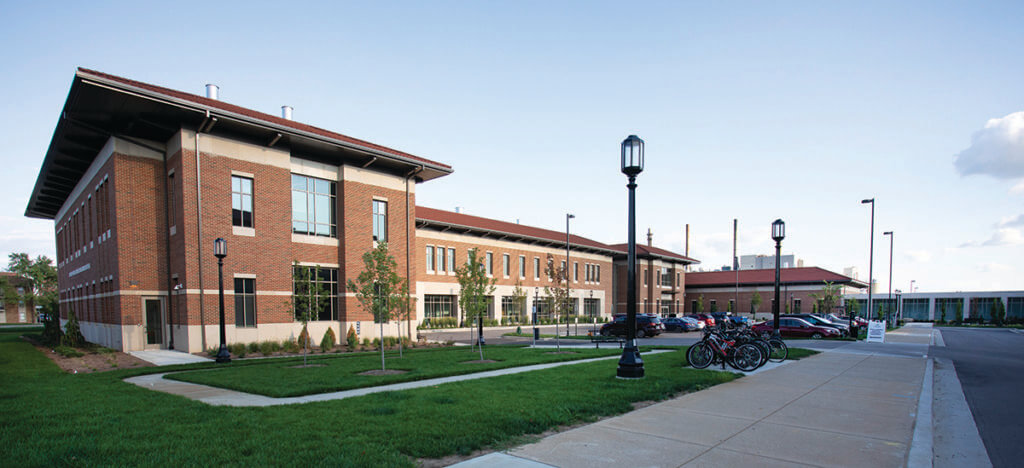
As morning light signals the dawn of a new day at the Purdue University College of Veterinary Medicine, the glistening new facilities that comprise the David and Bonnie Brunner Purdue Veterinary Medical Hospital Complex are ready for another busy schedule of appointments. Dedicated April 8, 2022, the hospital complex boasts advanced design and the latest equipment for treating patients, teaching students in the Doctor of Veterinary Medicine and Veterinary Nursing degree programs, and educating interns and residents.
The reality that the new structures are open and receiving patients is a welcome new normal for faculty and staff who had waited through years of planning and preparation for the new facilities to take shape. The $108 million facility covers 165,000 square feet on 13 acres just east of Lynn Hall, the home of the college ever since the first class of Purdue veterinary students enrolled in 1959. The space includes a major expansion of the Small Animal Hospital and a new Equine Hospital and Farm Animal Hospital that replaced the college’s original Large Animal Hospital.
Following the dedication ceremony, the move-in began and the new hospitals opened their doors to patients in May and June. The David and Bonnie Brunner Small Animal Hospital became the new home for more than a dozen specialty services, including Internal Medicine, Dialysis and Interventional Urology, Soft Tissue and Orthopedic Surgery, Neurology and Neurosurgery, Physical Rehabilitation, Emergency Services, the Intensive Care Unit, Isolation, Diagnostic Imaging, and Anesthesia. At the same time, services that remained in the Small Animal Hospital facilities in Lynn Hall gained access to the space vacated when the other services moved to the new complex. Among the services continuing to operate out of Lynn Hall are Small Animal Primary Care (including exotics and dentistry), Behavior, Dermatology, Ophthalmology, Oncology, Cardiology, Shelter Medicine and Surgery, Clinical Pathology, and Pharmacy.
“Enhancement of the learning environment, combined with the expertise of our faculty and staff, results in excellent patient care and contributes to the future of the veterinary profession,” said Dr. Ellen Lowery, Purdue University Veterinary Hospital director. “It is also important to recognize that expanding our hospital through the addition of the new structures has enabled the critical small animal outpatient services that operate out of Lynn Hall to optimize their capacity as well. Every service across our entire hospital is key to improving pet health, animal welfare, one health, and contributing to the education of the next generation of veterinarians and veterinary nurses.”
Dr. Jim Weisman, assistant dean for clinical education and clinical associate professor, says when it comes to learning, the advantages of the new facilities are plentiful. “With the new complex, our fourth-year students are now able to use state-of-the-art medical equipment in a space that facilitates greater clinician-student interaction,” Dr. Weisman explained. “The ability to have section-specific rounds rooms allows our students to have a ‘home-base’ that provides ample room for independent study, peer learning, and clinician-led instruction. In addition to enhanced clinical education, our new hospitals provide greater space and modern animal handling facilities to improve safety for our patients, students, staff, and faculty. All these factors combined elevate our learning environment, thus maximizing student success.”
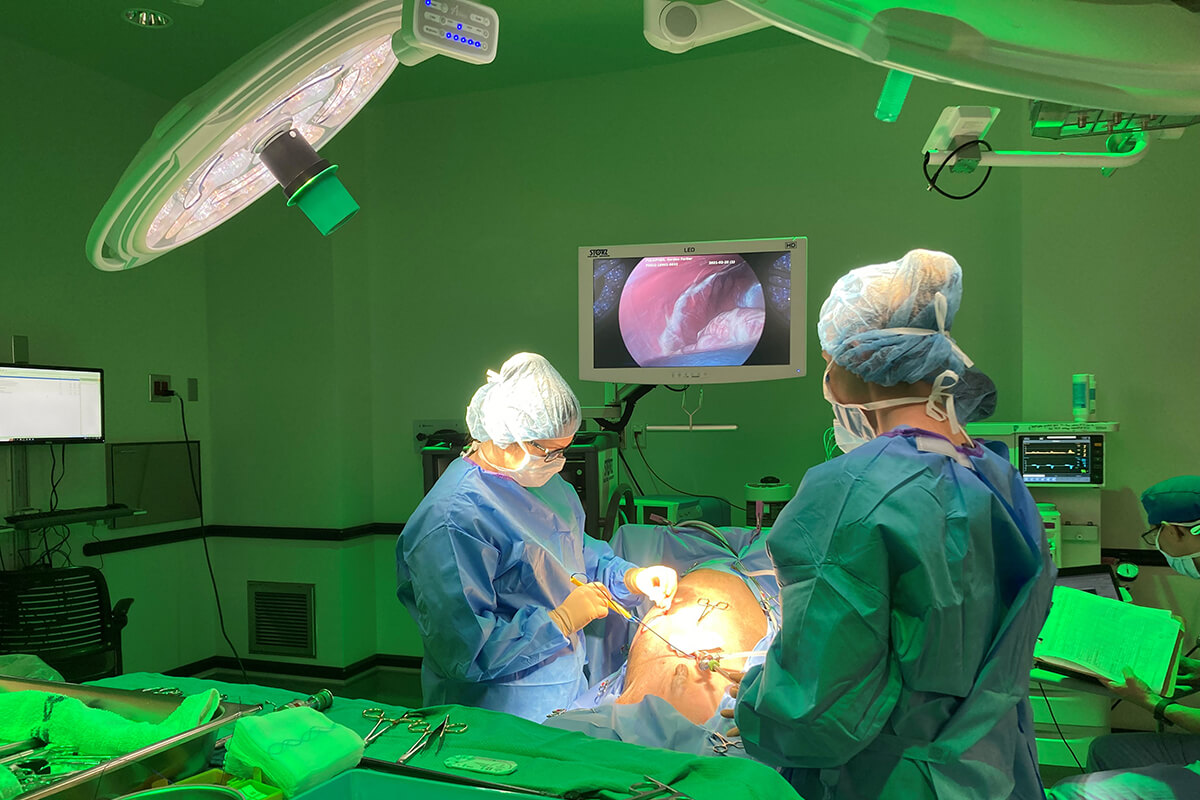
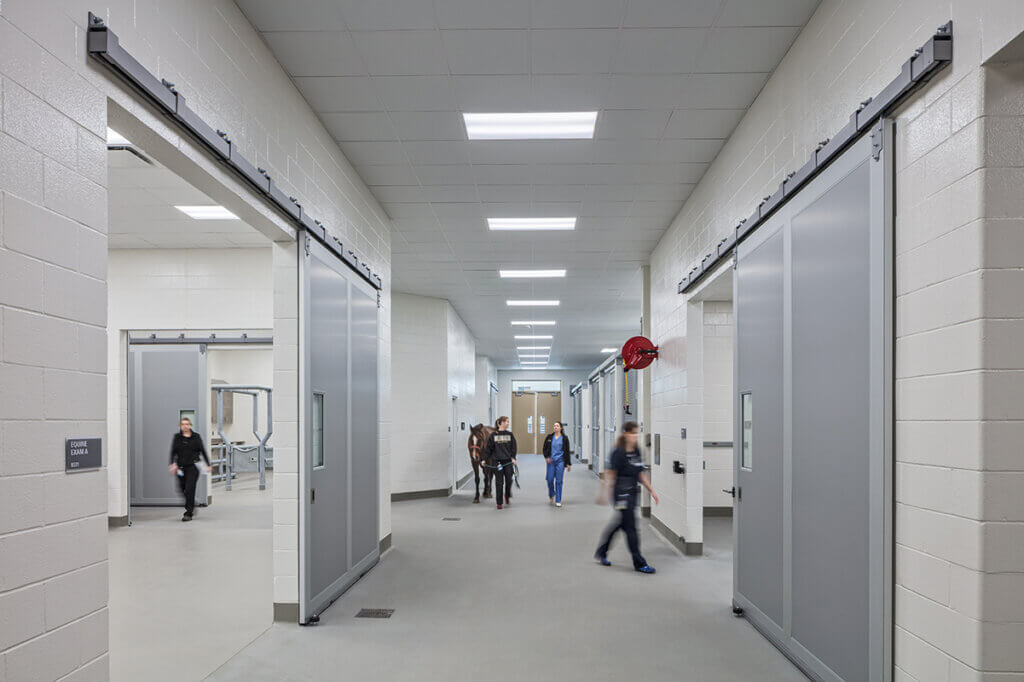
With a steady stream of clients bringing patients to the new buildings, one thing that is conspicuously absent in the new facilities is noise. Dr. Kathy Salisbury, associate dean for academic affairs and professor of small animal surgery, found that to be particularly noticeable in the Equine and Farm Animal Hospitals. “Because it is so quiet, it seems like there’s not much going on and that there are not many patients,” Dr. Salisbury said. “But then you go into the wards and there are lots of patients – it’s just that there’s quiet because things are spread out and less crowded.”
Dr. Salisbury has the seasoned perspective of a clinician with years of experience. She has served on the faculty since completing her Purdue residency in small animal surgery in 1984, and remembers what it was like working in the tight quarters of the original hospital facilities. “In the new surgery rooms, there’s space – they are not crowded and everyone can maintain appropriate aseptic technique because there is room to pass each other without brushing against someone or something.”
Another area where the expanded space is making a world of difference is in the Small Animal Hospital Emergency Service. “That’s a very demanding rotation for the students,” Dr. Salisbury explained. “Cases arrive unpredictably because they are emergencies, and students are expected to come up with plans on the spot – they don’t have a lot of time to look things up. Having a nice area with abundant natural light and space so they’re not running into each other all the time makes a big difference. Working in nice facilities with enough room for everybody helps to lower the stress level. It’s a huge improvement.”
Dr. Salisbury also points out that the quality of the new space provides an important lesson for students. “It shows the students the standard of care, with state-of-the-art equipment and space to reduce patient stress, and such building features as separate rooms for cats in multiple areas, which makes a big difference for feline patients.”
Dr. Lowery adds that the spacious environment also benefits clients. “The new facilities provide an open, welcoming environment for our clients,” Dr. Lowery said. “While waiting for their appointment time, the individual waiting ‘pods’ in the Small Animal Hospital offer windowed seating and work areas, providing increased comfort for clients and their pets. At the Equine and Farm Animal Hospitals, there is ample space for trailer parking, and separate overhead doors to unload horses depending on the specific service. And at the Farm Animal Hospital there’s drive-through unloading. These enhancements increase client convenience, comfort, and patient safety.”
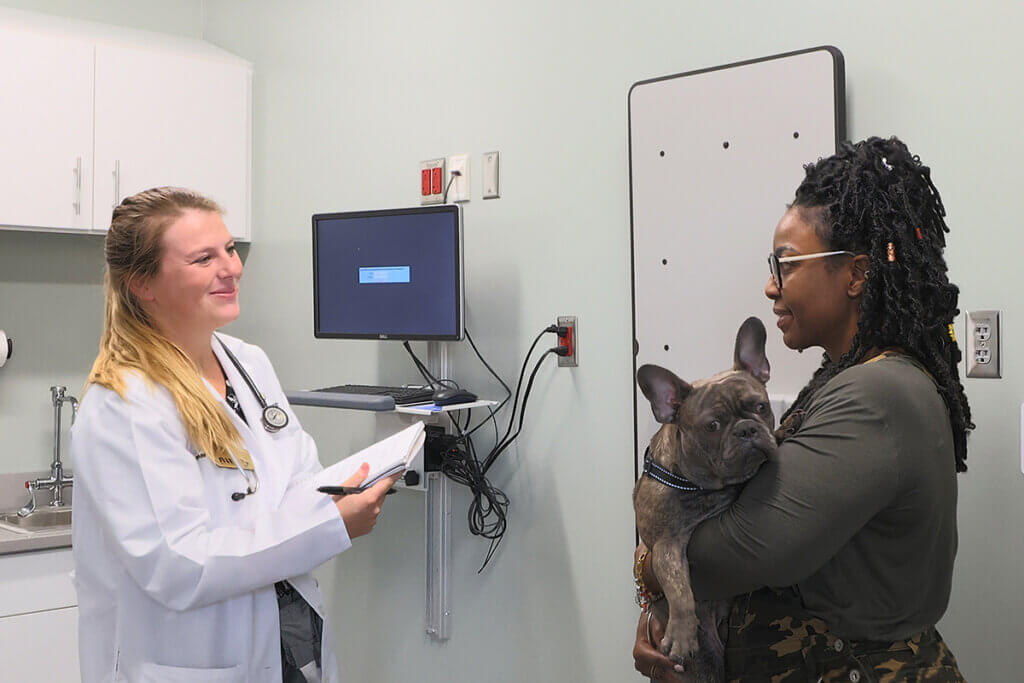
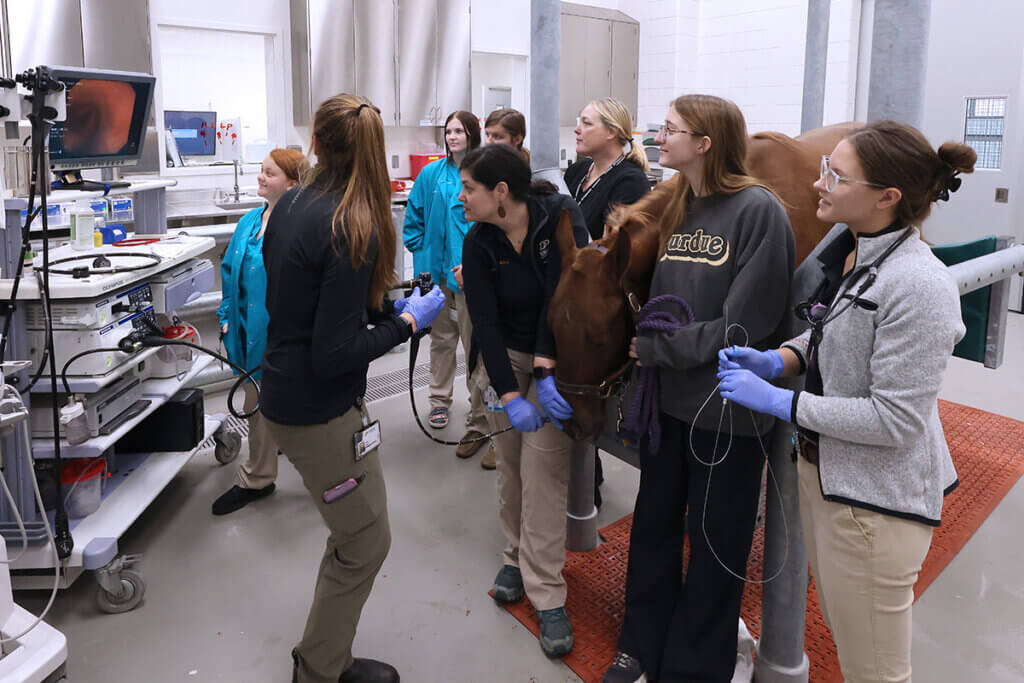
Dr. Weisman said when the students enter the new complex, they quickly comment on the size and scope of the hospitals and how that translates into their ability to see more cases and thus increase their learning. “The inclusion of dedicated student-centered learning spaces is another strong point identified by the students,” Dr. Weisman added. “These spaces were developed for them and are being used by them. Whether in the Equine, Farm Animal, or Small Animal Hospitals, students are provided greater opportunities for clinician-supervised patient management and care. Our students recognize this as a hallmark of excellence in their clinical education and share broadly the positive impact this has on their readiness to enter practice.”
Another benefit of the expanded hospital facilities is the impact on teamwork and shared learning experiences between the DVM and veterinary nursing students. Dr. Chad Brown, director of Veterinary Nursing Programs, says the veterinary nursing students have shared how they are benefitting directly from the more spacious treatment areas in the new complex. “Before the move, there were instances of our veterinary nursing students being unable to observe some of the procedures due to limited space,” Dr. Brown explained. “The expansion has really helped with our students’ exposure to all of the procedures and experiences that are part of their hospital rotations.”
Dr. Brown also says the increased caseloads and hospital space have allowed the veterinary nursing students more autonomy. “For example, the Intensive Care Unit, Physical Rehabilitation, and Emergency Service could only see limited numbers of patients due to physical space limitations before. Now that there are more treatment areas and exam rooms, our veterinary nursing students are being delegated more responsibility because there are multiple cases going on at the same time.” Dr. Brown adds that they also are being exposed to significantly more farm animal cases now that there is a specific hospital with adequate farm animal related equipment and space to accommodate the animals and the students. “This change is great for keeping students interested in farm animal medicine.”
Dr. Brown also points out that veterinary nursing students have noticed the impact of the increased number and size of the rounds rooms, where clinicians and students discuss the cases in the hospital. “These spaces have created team-based opportunities to learn alongside the DVM students. Everyone now rounds together in many of the rotations,” Dr. Brown explained. “The veterinary nursing students have been able to get to know the fourth-year DVM students better, as well as prepare plans to treat the patients together as a DVM and veterinary nursing team.”
Those sentiments are echoed by a neurology resident who worked in the old facilities when she was a veterinary student in the Class of 2020 and then as she started her residency. Now Dr. Jessica Linder is working in the new Small Animal Hospital. “One of the biggest improvements is the amount of physical space we have in order to interact with each other so that we can adequately teach students and discuss cases,” Dr. Linder said. “For example, in the original building, as our case load increased, the ICU on any given morning was quite busy and quite hectic. Our new ICU space is much larger, which allows us to spread out and assess and discuss our patients cage-side.
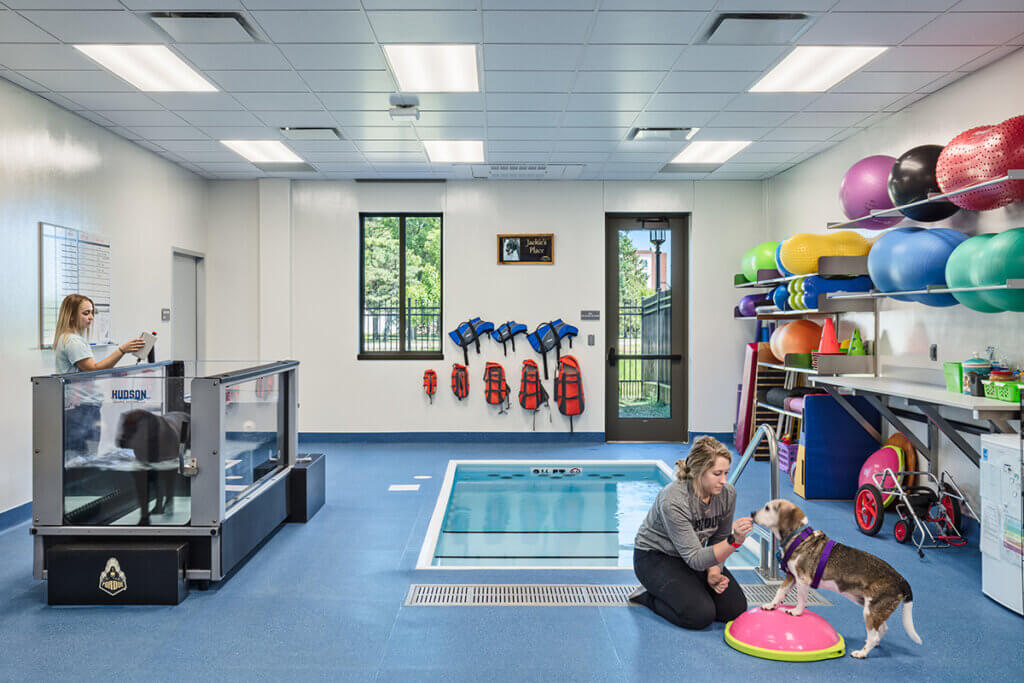
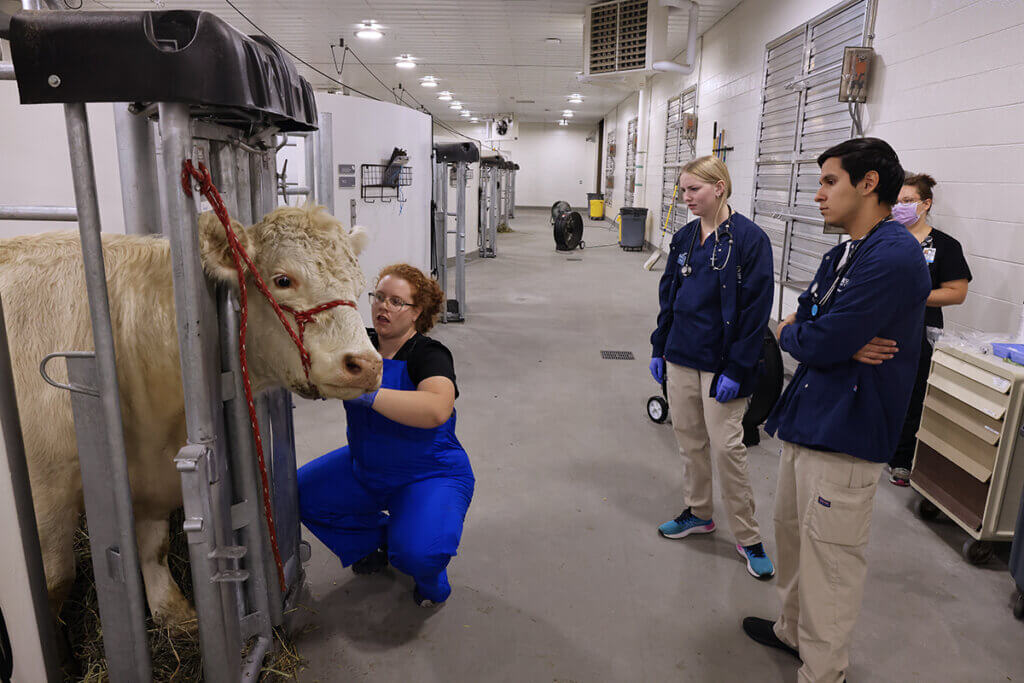
Intangibles also positively impact the learning environment. Everyone who works in the building has noticed the amount of daylight that brightens the work areas. “Having significantly more natural light throughout the new complex helps me stay focused, and I think others may agree with this as well,” Dr. Linder said. She also values the dedicated rounds room for each service. “Having our own rounds room has been fantastic. We have a large TV monitor where we are able to show our patients’ diagnostic imaging scans to our students. Having more space in general also gives us more space to assess our neurology patients. One of the components of our exams involves evaluating how patients walk. We now have more space to be able to assess patients without us getting in the way of other people.”
When all is said and done, the sentiment is unanimous — the new David and Bonnie Brunner Purdue Veterinary Medical Hospital Complex is a real dream come true, enhancing all aspects of teaching, learning, and patient care. “The goal of veterinary school is to prepare our graduates to be independent, effective, critical thinkers who possess strong technical skills and medical knowledge that they are ready to apply on day one of their practice career,” Dr. Weisman emphasized. “The new complex allows our students to gain an appreciation of the role of referral care while establishing a clear understanding of the role of primary care practitioners.”
An alumnus in the DVM Class of 1997, Dr. Weisman remembers what it was like to be a Purdue veterinary student himself and understands how these improvements reflect the enduring values of a Purdue veterinary education. “I am excited that Purdue continues to teach in an environment which utilizes and supports the full veterinary team concept,” Dr. Weisman said. “This rich experience will prepare our students to effectively manage and utilize their primary care team to their greatest potential which ultimately enhances patient care, client satisfaction, and veterinary professional satisfaction.”

